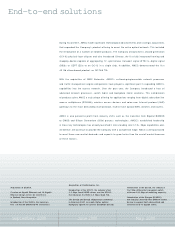3Ware 2001 Annual Report Download - page 18
Download and view the complete annual report
Please find page 18 of the 2001 3Ware annual report below. You can navigate through the pages in the report by either clicking on the pages listed below, or by using the keyword search tool below to find specific information within the annual report.1 6
B U S I N E S S O V E RV I E W
B U S I N E S S O V E RV I E W
We design, develop, manufacture and market high-performance, high-bandwidth silicon solutions for the world’s
optical networks. We utilize a combination of high-frequency analog, mixed-signal and digital design expertise cou-
pled with system-level knowledge and multiple silicon process technologies to offer integrated circuit products that
enable the transport of voice and data over fiber-optic networks. Our system solution portfolio includes PMD layer,
physical layer, framing layer, network processing layer and traffic management and switching layer devices that
a d d ress the high-performance needs of the evolving intelligent optical network. Our products target the
SONET/SDH, ATM, DWDM, Gigabit Ethernet and Fi b re Channel semiconductor markets. We provide our cus-
tomers with complete silicon IC solutions including PMD devices such as laser drivers, physical layer products such
as transceivers, framing layer products such as framers and mappers and higher layer processors such as network
processors and switch fabrics. Our products currently target data rates up to 40 gigabits per second (a rate known as
“OC-768”).
We continue to supply silicon ICs for the Automated Test Equipment (“ATE”), high-speed computing and military
markets. The re venues from these products have become less important as we have focused our business and operations
on communications mark e t s .
P R O D U C T C ATA G O R I E S
We have several types of communications IC products categorized by the order in which they receive and transmit
signals and information within communication equipment. These categories are:
P M D L AY E R :Our PMD layer ICs typically work in conjunction with the lasers or photo diodes that provide the
electrical-to-optical and optical-to-electrical signal conversions. These ICs include various amplifiers that take very
weak analog electrical signals (e.g., a few millivolts) and increase them for use by the physical layer. Our PMD layer
products transmit signals at rates ranging from 1 to 40 gigabits per second (“Gbps”).
P H Y S I C A L L AY E R :Our physical layer ICs transmit and receive signals to and from the PMD layer in a very high-
speed serial format (over 10 Gbps today) and reduce overall system “noise.” This low noise capability permits the
transmission of signals over greater distances with fewer errors. Our physical layer ICs also convert analog signals
from the PMD layer to digital signals for the framing layer and vice versa.
F R A M I N G L AY E R :Our framing layer ICs transmit and re c e i ve signals to and from the physical layer in a parallel format
and are used predominately in systems such as very high-speed transmission equipment, add-drop multiplexers,
digital and optical cross-connects, edge and core routers and DWDM. After receiving the signals, these ICs then
perform a number of additional functions, including framing, terminating the overhead, performance monitoring,
forward error correction and mapping the data payload to/from the transmission format. The framing layer ICs then
pass the data either directly to a switch fabric product, which switches the information to its destination, or to
a network processor, which further processes the data prior to forwarding it to a switch fabric product. Framing layer
ICs similarly process signals received from the network processing and switching layers for transmission to the
physical layer on their return to the optical network.
N E T W O R K P R O C E S S I N G L AY E R:Our network processor ICs are software programmable processors that receive and
transmit signals from and to the framing layer and perform the processing of packet and cell headers, including such
functions as real-time parsing, matching and table look-up, as well as bit stream manipulations, such as adding, delet-
ing, substituting, appending and pre-pending. They can perform intelligent packet classification for policy-based
network services. After processing, the signals are sent on to the traffic management and switch fabric layer.
T R A F F I C M A N A G E M E N T A N D S W I T C H I N G L AY E R:Our traffic management ICs re c e i ve and transmit signals from and to the
n e t w o r k processor and primarily perform the queuing and buffering re q u i r ed on packets before sending on to the switch
fabric. Our switch fabric ICs then switch the information in the proper priority and to the proper destinations.
























